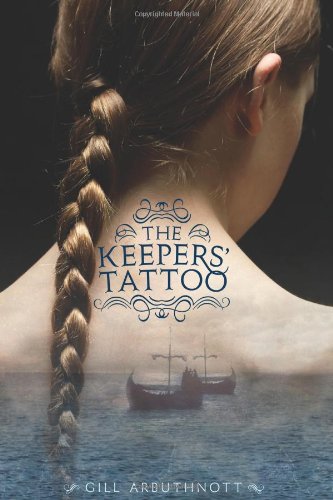
 The Keepers’ Tattoo by Gill Arbuthnott
The Keepers’ Tattoo by Gill Arbuthnott
The Keepers’ Tattoo, previously published as The Keepers’ Daughter in the U.K., is a young adult high fantasy with historical overtones. While it is set in an imaginary world, the story revolves around the earthquake-ruined city of Thira and the highly advanced “Keepers” who once lived there. Gill Arbuthnott is clearly drawing on the real-life Thera and the mysterious Minoan culture that may have inspired the legends of Atlantis. I’ve long been fascinated by all things Minoan, and so I loved this aspect of the novel.
As The Keepers’ Tattoo begins, young Nyssa is living an ordinary existence as a cook in her adoptive father’s tavern. Then, the Shadowmen — sinister henchmen of the tyrant Alaric — arrive in her small town, and Nyssa is quickly hustled away by Marius, an uncle she never knew she had. Marius tells Nyssa that she is being hunted for a tattoo she bears on the back of her head, which makes up half of a powerful spell. The other half was tattooed on her dead twin brother, Kit.
Nyssa and Marius seek only safety at first, but when Nyssa learns that her brother is in fact alive and a prisoner in Alaric’s palace, their flight becomes a quest to rescue him. They are joined by Nyssa’s friend Aria, a lady of the evening. (Note to Worried Parents: Aria’s profession is very subtly drawn and never practiced “onscreen.”) It will be nearly impossible to spirit Kit away from Alaric, and if they succeed, they will be fugitives again, hunted at every turn.
The characters remain a little distant throughout, and the prose is a mixed bag. Sometimes it’s workmanlike and plagued by frequent head-hopping. Sometimes it’s haunting, especially in its descriptions of Thira:
It was smaller than Nyssa had expected, but then half of it was in the sea. It seemed to melt into the water. The tide was out, exposing weed-swagged columns and fragments of walls, roofs of faded terra-cotta with gaping holes like open mouths, the remains of houses, shops, temples — all sorts of buildings.
A broad slipway of dressed stone, fraying now at the edges, led down into the blue water. As she looked at it, Nyssa realized it must have once been a processional way, leading down to a great temple whose column caps and shattered roof she could just glimpse breaking the waves, the farthest out of any of the visible drowned buildings.
Everywhere there were remnants of the great city that Thira had once been, but now it was a shadow and a memory: a ghost of its past.
The Keepers’ Tattoo is a long novel, and drags a little in places. There are several factors at work here. One is, I’ll admit, a personal issue of mine. I’ve never been much for a particular plot structure common in quest fantasy. This is the plot structure where characters travel to a town, escape some kind of danger there, travel to the next town, escape danger there, and so on. I know there are readers who like it, but it always starts feeling like D&D to me. Then there are the Alaric chapters. Many of these could have been shortened or removed without losing much from the plot. Mostly they tell us things we already know. The main narrative will tell or imply something, then we cut to Alaric sitting in his lair thinking about the same thing. I can’t speak for young adult readers, but to an adult reader these scenes feel a little like padding and a little like spoon-feeding.
However, The Keepers’ Tattoo is admirable for its vivid setting and complex history, and unusual in that it’s self-contained (no sequel bait here) and not focused on romance. In fact, Nyssa doesn’t even have a romance. (There is an understated romance between two other characters.) Depending on your tastes, this may be a good thing or a bad thing, but it’s definitely a different thing. This is not a book that will spark any “Team This Guy” vs. “Team That Guy” wars!



Seems like it could be an interesting read. Hopefully I’ll be able to find myself a copy to give it a try.
@Ria: It’s really got a lot going for it. It wasn’t my favorite book ever, but it’s unique and distinctive.